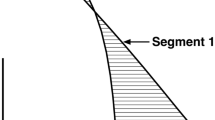Abstract.
Studies of multijoint arm movements have demonstrated that the nervous system anticipates and plans for the mechanical effects that arise from motion of the linked limb segments. The general rules by which the nervous system selects appropriate muscle activities and torques to best deal with these intersegmental effects are largely unknown. In order to reveal possible rules, this study examined the relationship of muscle and interaction torques to joint acceleration at the shoulder, elbow and wrist during point-to-point arm movements to a range of targets in the horizontal plane. Results showed that, in general, dynamics differed between the joints. For most movements, shoulder muscle torque primarily determined net torque and joint acceleration, while interaction torque was minimal. In contrast, elbow and wrist net torque were determined by a combination of muscle and interaction torque that varied systematically with target direction and joint excursion. This "shoulder-centered pattern" occurred whether subjects reached targets using straight or curved finger paths. The prevalence of a shoulder-centered pattern extends findings from a range of arm movement studies including movement of healthy adults, neurological patients, and simulations with altered interaction effects. The shoulder-centered pattern occurred for most but not all movements. The majority of the remaining movements displayed an "elbow-centered pattern," in which muscle torque determined initial acceleration at the elbow and not at the shoulder. This occurred for movements when shoulder excursion was <50% of elbow excursion. Thus, both shoulder- and elbow-centered movements displayed a difference between joints but with reversed dynamics. Overall, these findings suggest that a difference in dynamics between joints is a general feature of horizontal plane arm movements, and this difference is most commonly reflected in a shoulder-centered pattern. This feature fits well with other general shoulder-elbow differences suggested in the literature on arm movements, namely that: (a) agonist muscle activity appears more closely related to certain joint kinematics at the shoulder than at the elbow, (b) adults with neurological damage display less disruption of shoulder motion than elbow motion, and (c) infants display adult-like motion first in the shoulder and last at the wrist.
Similar content being viewed by others
Author information
Authors and Affiliations
Additional information
Electronic Publication
Rights and permissions
About this article
Cite this article
Galloway, J.C., Koshland, G.F. General coordination of shoulder, elbow and wrist dynamics during multijoint arm movements. Exp Brain Res 142, 163–180 (2002). https://doi.org/10.1007/s002210100882
Received:
Accepted:
Issue Date:
DOI: https://doi.org/10.1007/s002210100882




